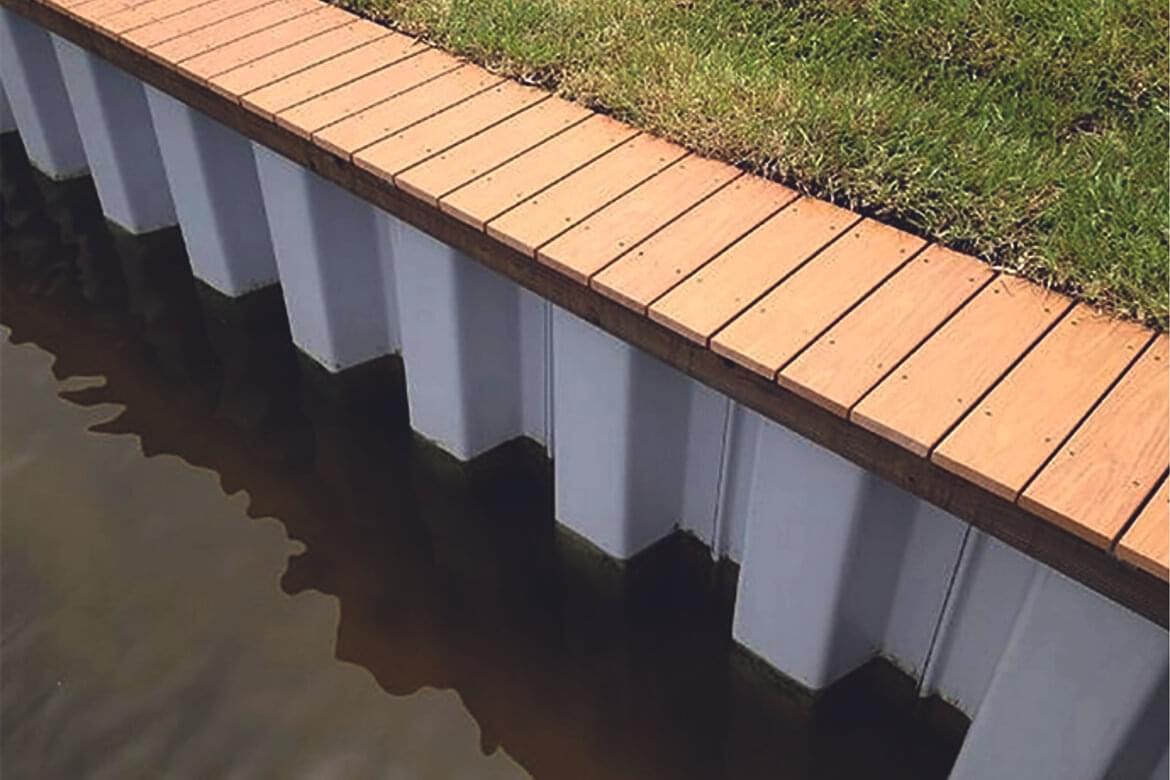Discovering the Various Usages of Bulkhead Frameworks in Modern Architecture
Bulkhead structures play a considerable function in modern-day style, offering both useful and aesthetic objectives. They can define spaces, improve storage options, and enhance illumination. In business setups, they work as focal factors that mirror brand name identity - Bulkhead on Lake Livingston. Furthermore, their combination commonly sustains sound administration and lasting techniques. Recognizing the full scope of their applications exposes much about modern layout patterns and individual experience. What ingenious uses bulkheads might arise in the future?
Defining Bulkhead Frameworks
Bulkhead frameworks play an essential function in modern architecture, functioning as necessary elements in different building layouts. These structures are typically specified as raised systems or ceilings, typically utilized to hide mechanical systems, electrical wiring, or plumbing. Bulkheads can be discovered in both industrial and residential setups, where they supply a seamless mix of performance and looks. Their style can integrate illumination components and various other attractive elements, enhancing the general visual appeal of a space.
Usually created from materials such as metal, wood, or drywall, bulkheads can be customized to fit the building design and demands of the structure (Bulkhead on Lake Livingston). They offer not just to conceal unattractive infrastructure however additionally to create defined areas within open spaces. By handling the circulation of an area, bulkheads add to the spatial company, making them a considerable facet of contemporary building technique. Their meaning envelops both practical and visual dimensions.
Useful Applications in Residential Style
Bulkhead structures play an important function in property style by promoting room optimization approaches that take full advantage of functional areas. Additionally, they add aesthetic layout elements that boost the aesthetic appeal of living areas. On top of that, these frameworks provide important architectural assistance options, making sure the integrity and safety and security of the home.
Area Optimization Methods
As contemporary residential layouts significantly prioritize efficient use area, innovative techniques arise to make the most of performance without giving up aesthetics. One famous method includes the combination of bulkhead frameworks, which can mark areas while supplying vital storage services. These structures can be used to develop vertical storage units that improve both organization and access. Furthermore, multi-functional furniture, such as foldable tables and exchangeable couches, complements bulkhead layouts, enabling rooms to adapt to differing demands. Open up flooring strategies further maximize spatial circulation, urging adaptability in use. Including built-in shelving and recessed illumination within bulkheads also adds to a structured setting, making sure that every square inch of room is utilized successfully and sympathetically within the total style.
Visual Style Components

Architectural Assistance Solutions
In modern-day household style, a reliable structural assistance remedy is essential for maintaining the stability of areas while enhancing design and functionality. Bulkhead structures play a considerable role in this circumstance, working as both assistance and partitioning elements. They can hide mechanical systems, such as plumbing and electric circuitry, while offering reinforcement to the ceiling and floor systems. By tactically putting bulkheads, designers can develop specified locations within open floor plans, improving use without endangering architectural stability. Additionally, these frameworks can fit illumination fixtures, adding to both appearances and functionality. To summarize, bulkhead frameworks are vital in property style, providing functional support remedies that improve both the functionality and visual allure of living rooms.
Enhancing Aesthetics in Industrial Rooms
When commercial spaces embrace cutting-edge bulkhead structures, they not just specify physical limits however additionally greatly enhance the total looks of the setting. These architectural components offer as visual focal factors, drawing attention and producing a sense of intrigue. By integrating varied materials such as glass, metal, or timber, bulkheads can show a brand name's identity and mission, adding to a cohesive layout.
The calculated placement of bulkheads can control light and shadow, including depth and dimension to or else flat areas. This interaction can change a business location right into a welcoming environment, urging customer interaction. Furthermore, using shade and structure in bulkhead style can stimulate specific feelings, improving the overall customer experience. Ultimately, the thoughtful assimilation of bulkhead structures raises the aesthetic charm of commercial areas, making them not just practical however additionally visually charming, thus promoting a lasting perception on visitors.
Acoustic Efficiency and Audio Management
Effective acoustic efficiency plays an essential duty in modern architecture, particularly within business spaces where sound management is vital. Bulkhead structures can considerably boost acoustic high qualities by taking in audio, lowering reverberation, and mitigating sound transfer between locations. These attributes are specifically beneficial in settings such as dining establishments, theaters, and offices, where clear communication and a positive auditory experience are paramount.
The tactical placement and style of bulkheads can help develop sound-buffer zones, efficiently isolating noisy locations from quieter ones. Products used in bulkhead building, such as soft finishes and acoustic panels, add to their sound-dampening abilities. Furthermore, the unification of bulkheads enables the combination of sound-absorbing elements without endangering visual appeal. By resolving acoustic efficiency, designers can produce harmonious atmospheres that enhance comfort, improve individual experience, and advertise productivity, making bulkheads a vital part in the layout of contemporary commercial rooms.
Integrating Bulkheads for Efficient Room Usage
Commonly neglected, the assimilation of bulkheads in building layout can significantly boost area use in modern-day structures. These structural aspects offer numerous useful purposes, supplying a way to hide mechanical systems, electric circuitry, and plumbing without compromising looks. By strategically positioning bulkheads, engineers can develop defined locations within open layout, consequently assisting in much better organization and circulation.
Bulkheads can incorporate storage solutions and illumination functions, optimizing the performance of or else wasted vertical area. In domestic settings, they might define areas such as kitchen areas or living locations, while in commercial spaces, they can boost the performance of layouts by clearly noting pathways and workspace.
Eventually, the thoughtful integration of bulkheads adds to an extra aesthetically attractive and orderly environment, enabling for adaptable spaces that can develop with the requirements of their occupants. This strategy not only maximizes space yet additionally promotes a more unified interaction in between kind and function.
Bulkheads in Public Design

Building Aesthetic Enhancements
While several building aspects goal for capability, bulkheads in public design serve a twin function by enhancing visual appeal. These structures frequently produce visual interest with their layout, incorporating flawlessly with surrounding elements. By employing different products, appearances, and colors, bulkheads can add to an one-of-a-kind identity for public spaces, such as airports, museums, and libraries. Their critical placement aids to define locations, directing visitors while adding depth to the total design. In addition, bulkheads can emphasize illumination, producing vibrant environments that transform throughout the day. This aesthetic enhancement not only raises the visitor experience but additionally cultivates a local color, making bulkheads a necessary factor to consider in modern public design. Generally, bulkheads personify the combination of kind and function.

Structural Assistance Solutions
As designers seek cutting-edge ways to boost the architectural integrity of public spaces, bulkheads arise as necessary elements in the layout and construction process. These structures supply vital assistance, especially in locations based on hefty foot website traffic or dynamic loads. By dispersing weight evenly, bulkheads help prevent architectural failing while permitting flexible layout choices. In large places, such as arenas and convention facilities, bulkheads are frequently incorporated into the total architectural framework, websites making sure stability and security. Additionally, they can help with the incorporation of utilities and mechanical systems, contributing to the effectiveness of area usage. Ultimately, bulkheads stand for an essential service in contemporary public architecture, strengthening both functionality and safety in community-focused settings.
Environmental Management Procedures
Incorporating environmental management measures right into public architecture has become progressively essential as urban designers focus on sustainability along with structural assistance. Bulkhead structures offer a dual purpose in this regard, functioning as obstacles versus disintegration and flooding while concurrently boosting the aesthetic allure of urban landscapes. Their style typically consists of natural environments such as vegetation, which can enhance air high quality and supply habitats for wildlife. Furthermore, bulkheads can be engineered with absorptive products that enable water absorption, lowering drainage and advertising groundwater recharge. This integration of environmental considerations not just maintains the atmosphere but likewise cultivates area resilience against climate modification. By utilizing bulkheads properly, designers add to lasting city growth that straightens with contemporary ecological objectives.
Future Trends in Bulkhead Design
Arising patterns in bulkhead style show a growing emphasis on sustainability, advancement, and functionality in modern-day style. Developers are significantly incorporating environment-friendly products, such as recycled composites and bioplastics, to decrease ecological effect. Additionally, the assimilation of smart innovation is ending up being prevalent, enabling bulkheads to offer multi-functional purposes, consisting of energy storage space and environment control.
In metropolitan setups, modular bulkhead systems are getting grip, providing adaptability in layout and convenience of installment. These systems can be adjusted to different landscapes, permitting efficient space utilization. Furthermore, aesthetic considerations are evolving; bulkheads are now being developed to improve aesthetic allure, usually integrating artistic aspects that reverberate with neighborhood culture.
As environment resilience comes to be a concern, future bulkhead layouts will likely prioritize flooding defense and stormwater administration, making certain architectural honesty while attending to ecological obstacles. This shift signifies a recommended you read holistic approach to style that satisfies both human needs and eco-friendly duties.
Often Asked Questions
What Materials Are Frequently Utilized for Bulkhead Construction?
Usual materials for bulkhead building and construction include concrete, steel, wood, and composite materials. These alternatives give toughness, architectural stability, and resistance to ecological variables, making them suitable for various applications in building and construction and design tasks.
How Do Bulkheads Influence Building Energy Performance?
Bulkheads boost constructing power effectiveness by supplying thermal insulation and decreasing air leakage (Bulkhead on Lake Livingston). They help maintain interior temperature levels, consequently decreasing home heating and cooling needs, ultimately leading to lower power costs and boosted environmental sustainability
Are There Any Kind Of Building Regulations Details to Bulkhead Structures?
Yes, developing codes details to bulkhead structures exist, varying by place. These regulations typically deal with safety, structural integrity, and availability, ensuring that bulkheads meet called for requirements for building and construction and layout within a provided jurisdiction.
Can Bulkheads Be Conveniently Changed or Removed Later On?
Bulkheads can often be changed or eliminated, depending upon their layout and building. However, such modifications may call for careful preparation and adherence to building regulations to assure architectural honesty and security are kept throughout the process.
What Are the Costs Related To Setting Up Bulkhead Structures?
The prices linked with mounting bulkhead frameworks can vary significantly, generally influenced by products, style intricacy, and labor. Normally, costs vary from moderate to high, relying on the task's particular needs and location.
Bulkhead frameworks play an important function in modern-day architecture, serving as important parts in different building styles. Bulkhead structures play an important role in residential style by assisting in space optimization approaches that make the most of useful locations. Frequently forgotten, the assimilation of bulkheads in architectural design can considerably boost space use see here in modern-day buildings. As architects look for cutting-edge methods to improve the architectural stability of public spaces, bulkheads emerge as essential parts in the design and building process. The prices associated with mounting bulkhead frameworks can differ considerably, generally influenced by products, design complexity, and labor.